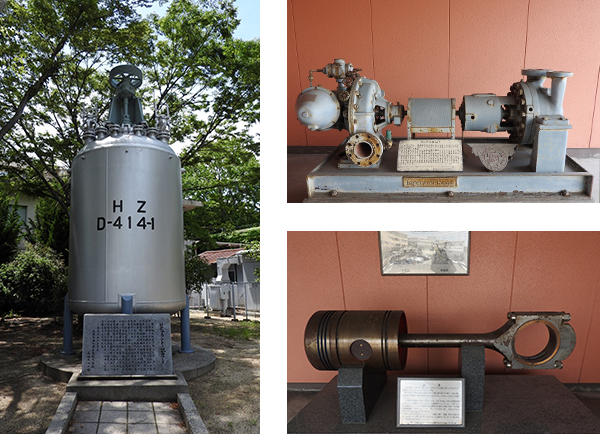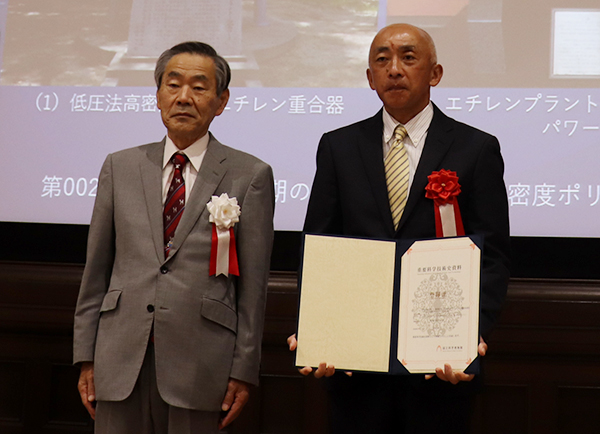Mitsui Chemicals Awarded Future Technology Heritage Status for Equipment at Iwakuni-Ohtake Works
Recognized as the world’s first equipment for commercial production of low-pressure polyethylene
2020.09.16
Mitsui Chemicals, Inc.
Mitsui Chemicals, Inc. (Tokyo: 4183; President & CEO: HASHIMOTO Osamu) is proud to announce that the polyethylene manufacturing equipment at its Iwakuni-Ohtake Works has been registered by the National Museum of Nature and Science (NMNS) as future technology heritage.*1 The registration certificate was presented to Mitsui Chemicals on September 15. Mitsui Chemicals is honored by the NMNS’s acknowledgement and intends to preserve this precious asset for future generations.
This marks the third time that items belonging to Mitsui Chemicals have been registered as future technology heritage, following the registration of artifacts from Japan’s early Claude process ammonia production (registration no. 00095*2; location: Shimonoseki Mitsui Chemicals, Inc.) in 2012 and items related to Japan’s first synthetic indigo dye (registration no. 00216*3; location: Mobara Branch Factory) in 2016.
Future Technology Heritage
Officially named “Important Specimens from the History of Science and Technology,” this registration system was launched in 2008 by the NMNS’s Center of the History of Japanese Industrial Technology. Its purpose is to promote the preservation and use of historically significant materials in Japan, showcasing important achievements in the development of science and technology so that they can be passed on to future generations. The initiative also encompasses materials from the history of science and technology that have had a notable impact on Japanese lifestyles and on the nation’s economy, society and culture.


From Left: Dr.HAYASHI Yoshihiro/ President NMNS
Mr.TAKAHASHI Shinichi / MCI Iwakuni-Ohtake Works
Overview of the Registered Materials
| Registration No. | 00286 The world’s first low-pressure high-density polyethylene manufacturing equipment |
|---|---|
| Name | [The world’s first low-pressure high-density polyethylene manufacturing equipment] (1) Low-pressure high-density polyethylene (HDPE) polymerization vessel (2) Raw material feed pump of an ethylene plant (3) Powered piston from the No. 2 compressor at an ethylene plant |
| Reason for Selection | These materials are items of manufacturing equipment ((1) polymerization vessel, (2) raw material naphtha feed pump and (3) powered piston for a gas engine) for low-pressure polyethylene from the early years of petrochemical industrial complexes in Japan. This method of manufacturing low-pressure HDPE was discovered by German chemist Karl Ziegler in 1955. The industrial complexes in Japan were among the first in the world to achieve industrial-scale manufacturing using this method. The petrochemical industry started out centered around American oil refining technology and German coal chemistry. Based on these technologies, the industry developed further technologies to synthesize polymers such as organic and inorganic chemicals and synthetic rubber, as well as large-scale synthesis of synthetic oil. In Japan, the growth of the industry kept pace with the West, fueled by naphtha from Middle Eastern crude oil. These materials from Japan’s first industrial oil complex were among the first equipment in the world used to commercialize low-pressure HDPE with the Ziegler method. These signify an important step in technology development.*4 |
| Location | On the premises of Mitsui Chemicals Iwakuni-Ohtake Works*5 |
References
*1Future technology heritage (Japanese site only)
*2Artifacts from Japan’s early Claude process ammonia production
*3Items Related to Japan’s First Synthetic Indigo Dye
*4Introduction of Ziegler-processed polyethylene – see “Our History” on the Mitsui Chemicals website
